User:Transhumanist/List of nutrition-related topics
General dietary terms[edit]
- Adaptogen
- Adenosine triphosphate (ATP)
- Advanced glycation endproduct
- Amino acid
- Appetite
- Ark of taste
- Aristology
- Artificial flavors
- Artificial sweeteners
- Baking
- Barbecue
- Binge eating
- Biosafety
- Blood sugar
- Bodybuilding nutrition
- Bodybuilding supplement
- BCAA (branched chain amino acids)
- Branched chain amino acids
- Bread
- Breakfast
- Brunch
- Calorie
- Calorie counting
- Calorie restriction
- Carbohydrate
- Carcinogen
- Cholesterol
- Chronic toxicity
- Codex Alimentarius
- Complex carbohydrate
- Compulsive overeaters
- Confectionery
- Conventional food
- Cooking
- Cuisine
- Dabbawala
- Daily value (DV)
- Dairy product
- Danger zone
- Deficiency disease
- Deep frying
- Deep fried foods
- Dehydration
- Dessert
- Detoxification
- Diabetes
- Diet
- Dietary fiber
- Diet food
- Dietary mineral
- Dietary supplement
- Dietetics
- Diet food
- Dietitian
- Diets (list)
- Digestion
- Digestive system
- Digestive tract
- Dinner
- Drink
- Drug
- DV (daily value)
- Eating disorders
- ECA stack
- Elevenses
- Empty calorie
- Energy drink
- Enzymes
- Ergogenic aids
- Essential amino acid
- EFA (essential fatty acid)
- Essential fatty acids
- Exercise
- Fad diet
- Famine
- Fast Food (see also Slow Food)
- Fat
- Fat tax
- FDA
- Flavonoids
- Flavor
- Flavoring
- Fiber, dietary
- Food
- Food additive
- Food allergy
- Food and agricultural policy
- Food and cooking hygiene
- Food and Drug Administration
- Food and Drugs Act
- Food and Nutrition Service
- Food bank
- Foodborne illness
- Food coloring
- Food craving
- Food energy
- Food faddism
- Food guide pyramid
- Food groups
- Food labelling Regulations
- Food politics
- Food pyramid
- Food preservation
- Food preservatives
- Food processing
- Food processor
- Food quality
- Food Safety and Inspection Service
- Food Salvage
- Food science
- Food security
- Food sensitivity
- Food Stamp Program
- Food Standards Agency (UK)
- Food storage
- Food supplements
- Food technology
- Free radical
- Freezer burn
- French paradox
- Frozen food
- Fruit
- Fried foods
- Frying
- Functional food
- Genetically modified food
- Glucose (monosaccharide)
- Glucose meter
- Glucose tolerance factor (GTF)
- Glycemic Index
- Glycemic Load
- Glycogen
- Grilling
- GreySheeters Anonymous
- Growth hormone
- Health
- Health claims on food labels
- Healthy diet
- Healthy eating
- Herb
- High density lipoprotein cholesterol
- HDL (high density lipoprotein cholesterol)
- Hypoglycemia
- Ideal weight
- Illnesses related to poor nutrition
- Incompatible Food Triad
- Inflammation
- Insulin
- Irradiation
- Isoflavones
- Junk food
- Kilojoule
- Lactoferrin
- Life extension
- Life extension nutrition
- Lipotropic nutrients
- List of foods named after people
- Local food
- Low-carbohydrate diet
- Lunch
- Macronutrient
- Malnutrition
- Meat
- Micronutrient
- Milk
- Mineral
- Monounsaturated fat
- Multivitamin
- Multimineral
- Multinutrient
- Mutagen
- Nootropic
- Nutraceutical
- Nutrient
- Nutrient density
- Nutrigenomics
- Nutrition
- Nutritional facts
- Nutritional genomics
- Nutrition and bodybuilding
- Nutrition and longevity
- Nutrition and pregnancy
- Nutrition Labeling and Education Act
- Nutrition physiology
- Nutrition taboos
- Obesity
- Optimal weight
- Organic acid
- Organic food
- Overeaters Anonymous
- Overeating
- Paleolithic diet
- Pasteurization
- Phytochemicals
- Phytonutrients
- Potluck
- Prenatal nutrition
- Preventive medicine
- Prohormone
- Prostaglandins
- Protein
- Raw food diet
- RDA
- RDI
- Regional variations of barbecue
- Salad bar
- Saturated fat
- Second breakfast
- Seed
- Service à la française
- Service à la russe
- Simple carbohydrate
- Sitophilia
- Slow Food (see also Fast food
- Somatotropin
- Snack
- Snacking
- Snap freezing
- Spice
- Sports nutrition
- Starch
- Stir fry
- Sugar
- Sulfate
- Sulfite
- Super Size Me
- Supplement, dietary
- Supper
- Sweetener
- Sweets
- Table d'hôte
- Taboo food and drink
- Tea (meal)
- Teratogen
- Thermogenics
- Tiffin
- Toxicology
- Toxicity
- Toxins
- Traditional Chinese medicine
- Trans fat
- Trans-fatty acids
- Triglycerides
- USDA
- Vacuum evaporation
- Vegan
- Vegan nutrition
- Vegetable
- Vegetarian
- Vegetarianism
- Vitamin
- Water
- Weight loss
- Yo-yo dieting
Diets and Dieting[edit]
See also List of diets
- Bodybuilding nutrition
- Calorie restriction
- Cognitive enhancement nutrition
- Dietary supplement
- Fruitarianism
- Life extension nutrition
- Low-carbohydrate diet
- Prenatal nutrition
- Raw food diet
- Sports nutrition
- Vegetarianism
- Weight loss
- Yo-yo dieting
Macronutrients[edit]
Water[edit]
Protein[edit]
Amino Acids[edit]
- Standard amino acids
- Alanine
- Arginine
- Aspartic acid (aspartate)
- Asparagine
- Cystine
- Glutamic acid (glutamate)
- Glutamine
- Glycine
- Histidine
- Isoleucine (branched chain amino acid)
- Leucine (branched chain amino acid)
- Lysine
- Methionine
- Phenylalanine
- Proline
- Serine
- Threonine
- Tryptophan
- Tyrosine
- Valine (branched chain amino acid)
- Other amino acids
Fat[edit]
Saturated fats[edit]
- Butyric acid
- Caprioc acid
- Caprylic acid
- Capric acid
- Lauric acid
- Myristic acid
- Pentadecanoic acid
- Palmitic acid
- Heptadec acid
- Stearic acid
- Arachidic acid
- Behenate acid
- Tetracos acid
Monounsaturated fats[edit]
Polyunsaturated fats[edit]
- Linoleic acid
- Linolenic acid
- Stearidon
- Eicosatrienoic
- Arachidon
- EPA (eicosapentaenoic acid) - an essential fatty acid
- DPA
- DHA (docosahexaenoic acid) - an essential fatty acid
Essential fatty acids[edit]
Other Fats[edit]
Fat substitutes[edit]
Carbohydrates[edit]
Dietary fiber[edit]
Starch[edit]
Sugars[edit]
Sugar substitutes[edit]
- Artificial sugar substitutes
- Acesulfame-K —
- Acesulfame potassium — 200x sweetness (by weight), Nutrinova, E950, FDA Approved 2003
- Alitame — 2,000x sweetness (by weight), Pfizer, Pending FDA Approval
- Aspartame — 160-200x sweetness (by weight), NutraSweet, E951, FDA Approved 1981
- Cyclamate — 30x sweetness (by weight), Abbott, E952, FDA Banned 1969, pending re-approval
- Dulcin — 250x sweetness (by weight), FDA Banned 1950
- Neohesperidine dihydrochalcone — 1,500x sweetness (by weight), E959
- Neotame — 8,000x sweetness (by weight), NutraSweet, FDA Approved 2002
- P-4000 — 4,000x sweetness (by weight), FDA Banned 1950
- Saccharin — 300x sweetness (by weight), E954, FDA Approved 1958
- Sucralose — 600x sweetness (by weight), Tate & Lyle, FDA Approved 1998
- Natural sugar substitutes
- Brazzein — Protein, 2,000x sweetness of sucrose (by weight), Exxx
- Curculin — Protein, 550x sweetness (by weight), Exxx
- Erythritol — 0.7x sweetness (by weight), 14x sweetness of sucrose (by food energy), 0.05x energy density of sucrose
- Fructose —
- Glycyrrhizin — 50x sweetness (by weight)
- Glycerol — 0.6x sweetness (by weight), 0.55x sweetness (by food energy), 1.075x energy density, E422
- Hydrogenated starch hydrolysates — 0.4x–0.9x sweetness (by weight), 0.5x–1.2x sweetness (by food energy), 0.75x energy density
- Isomalt — 0.45x–0.65x sweetness (by weight), 0.9x–1.3x sweetness (by food energy), 0.5x energy density, E953
- Lactitol — 0.4x sweetness (by weight), 0.8x sweetness (by food energy), 0.5x energy density, E966
- Mabinlin — Protein, 100x sweetness (by weight), Exxx
- Maltitol — 0.9x sweetness (by weight), 1.7x sweetness (by food energy), 0.525x energy density, E965
- Mannitol — 0.5x sweetness (by weight), 1.2x sweetness (by food energy), 0.4x energy density, E421
- Miraculin — Protein, nx sweetness (by weight), Exxx
- Monellin — Protein, 3,000x sweetness (by weight), Exxx
- Pentadin — Protein, 500x sweetness (by weight), Exxx
- Sorbitol — 0.6x sweetness (by weight), 0.9x sweetness (by food energy), 0.65x energy density, E420
- Stevia — 250x sweetness (by weight)
- Tagatose — 0.92x sweetness (by weight), 2.4x sweetness (by food energy), 0.38x energy density
- Thaumatin — Protein, — 2,000x sweetness (by weight), E957
- Xylitol — 1.0x sweetness (by weight), 1.7x sweetness (by food energy), 0.6x energy density, E967
Micronutrients[edit]
Vitamins[edit]
- Vitamin A (retinol)
- Vitamin B complex
- Vitamin C (Ascorbic acid)
- Vitamin D IU=mcg
- Vitamin E (tocopherol) IU=mg
- Vitamin K
- Biotin
- Carotenoids
- Folate (DFE)
Minerals[edit]
- Boron
- Calcium
- Chloride
- Chromium
- Copper
- Fluoride
- Iodine
- Iron
- Magnesium
- Manganese
- Molybdenum
- Phosphorus
- Potassium
- Selenium
- Sodium
- Zinc
Organic Acids[edit]
Foods[edit]
See also List of food additives
Pyramid Groups[edit]
Seeds[edit]
- Almonds
- Amaranthus
- Beans/Legumes, including
- Cocoa
- Carob tree
- Cereals, including
- Coconuts
- Common Hazel
- Coriander
- Ginkgo
- Monkey-puzzle
- Mustards
- Pine nuts, including
- Quinoa
- Rambutan
- Sunflower seeds
- Poppy seeds
- Pumpkin seeds
- Sesame seeds
- Durian seeds
Fruit[edit]
Temperate fruits[edit]
Fruits of temperate climates are almost universally borne on trees or woody shrubs or lianas. They will not grow adequately in the tropics, as they need a period of cold (a chilling requirement) each year before they will flower. The apple, pear, cherry, and plum are the most widely grown and eaten, owing to their adaptability. Many other fruits are important regionally but do not figure prominently in commerce. Many sorts of small fruit on this list are gathered from the wild, just as they were in Neolithic times.
Rosaceae family[edit]
The Family Rosaceae dominates the temperate fruits, both in numbers and in importance. The pome fruits, stone fruits and brambles are fruits of plants in Rosaceae.
The pome fruits:

- Apple and crabapple (Malus) - Nutritional information about the apple
- Chokeberry also called cooking apple (Aronia)
- Hawthorn (Crataegus and Rhaphiolepis)
- Serviceberry or saskatoon (Amelanchier)
- Loquat (Eryobotrya japonica)
- Medlar (Mespilus germanica)
- Pear, European and Asian species (Pyrus)
- Quince (Cydonia oblonga and Chaenomeles)
- Rowan (Sorbus)
- Service tree (Sorbus domestica), bears a fruit known as a sorb or sorb apple
- Rose-hip, the fruitlike base of roses (Rosa); used mostly for jams and herbal tea
- Shipova (× Sorbopyrus auricularis)
The stone fruits, drupes of genus Prunus:
- Apricot (Prunus armeniaca or Armeniaca vulgaris)
- Cherry, sweet, sour, and wild species (Prunus avium, P. cerasus, and others)
- Plum, of which there are several domestic and wild species; dried plums are called prunes
- Peach (of the normal and white variety) and its variant the nectarine (Prunus persica)
- Chokecherry (Prunus virginiana)
- Hybrids of the preceding species, such as the pluot, aprium and peacotum
Berries[edit]
In non-technical usage, berry means any small fruit that can be eaten whole and lacks objectionable seeds. The bramble fruits, compound fruits of genus Rubus (blackberries), are some of the most popular pseudo-berries:

- Blackberry, of which there are many species and hybrids, such as dewberry, boysenberry, and loganberry (genus Rubus)
- Raspberry, several species (genus Rubus)
- Cloudberry (Rubus chamaemorus)
- Wineberry (Rubus phoenicolasius)
- Salmonberry (Rubus spectabilis)
- Loganberry (Rubus loganobaccus)
The true berries are dominated by the family Ericaceae, many of which are hardy in the subarctic:
- Bearberry (Arctostaphylos spp.)
- Bilberry or whortleberry (Vaccinium spp.)
- Blueberry (Vaccinium spp.)
- Crowberry (Empetrum spp.)
- Timberry (Ellisium spp.)
- Cranberry (Vaccinium spp.)
- Huckleberry (Vaccinium spp.)
- Lingonberry (Vaccinium vitis-idaea)
- Strawberry Tree (Arbutus unedo), not to confuse with the Strawberry (Fragaria)
Other berries not in the Rosaceae or Ericaceae:
- Barberry (Berberis; Berberidaceae)
- Currant (Ribes spp.; Grossulariaceae), red, black, and white types
- Elderberry (Sambucus; Caprifoliaceae)
- Gooseberry (Ribes spp.; Grossulariaceae)
- Hackberry (Celtis spp.; Cannabaceae)
- Honeysuckle: the berries of some species (called honeyberries) are edible, others are poisonous (Lonicera spp.; Caprifoliaceae)
- Mayapple (Podophyllum spp.; Berberidaceae)
- Nannyberry or sheepberry (Viburnum spp.; Caprifoliaceae)
- Oregon grape (Mahonia aquifolium; Berberidaceae)
- Sea-buckthorn (Hippophae rhamnoides; Elaeagnaceae)
- Sea Grape (Coccoloba uvifera; Polygonaceae)
- Wolfberry (Lycium barbarum, Lycium spp.; Solanaceae)
- Mulberry (Morus spp.; Moraceae)
Fruits of Asian origin[edit]
Some fruits native to Asia that were not common elsewhere until the 20th century:
- Arhat (Siraitia grosvenorii; Siraitia; Cucurbitaceae) Also called longevity fruit
- Che (Cudrania tricuspidata; Cudrania; Moraceae) Also called Cudrania, Chinese Mulberry, Cudrang, Mandarin Melon Berry, Silkworm Thorn, zhe
- Goumi (Elaeagnus multiflora ovata; Elaeagnus; Elaeagnaceae)
- Kiwifruit or Chinese gooseberry (Actinidia spp.; Actinidiaceae)
- Persimmon (Diospyros kaki; Diospyros; Ebenaceae)
- Sageretia (Sageretia theezans; Sageretia; Rhamnaceae) Also called Mock Buckthorn
Fruits of American origin[edit]
Some other fruits native to North America that are eaten in a small way:
- American grape: North American species (e.g., Vitis labrusca; Vitaceae) and American-European hybrids are grown where grape (Vitis vinifera) is not hardy and are used as rootstocks
- American Mayapple (Podophyllum peltatum; Berberidaceae)
- American persimmon (Diospyros virginiana; Ebenaceae)
- Buffaloberry (Shepherdia argenta; Elaeagnaceae), which grows wild in the prairies of Canada
- Canada Buffaloberry (Shepherdia canadensis; Elaeagnaceae), also known as soopolallie or soapberry
- Cocoplum (Chrysobalanus icaco; Chrysobalanaceae)
- Cranberry (Vaccinium oxycoccus)
- False-mastic (Mastichodendron foetidissimum; Sapotaceae)
- Ground Plum (Astragalus caryocarpus; Fabaceae), also called Ground-plum milk-vetch
- Murta (Ugni molinae Turcz.; Myrtaceae)
- Pigeon plum (Coccoloba diversifolia; Polygonaceae)
- Salal berry (Gaultheria shallon; Ericaceae)
- Salmonberry (Rubus spectabilis; Rosaceae)
- Saw Palmetto (Serenoa repens; Ericaceae)
- American Pawpaw (Asimina triloba; Annonaceae, not to be confused with Papaya (Carica papaya; Caricaceae), which is called pawpaw outside of the USA)
- Texas persimmon (Diospyros texana; Ebenaceae)
- Thimbleberry (Rubus parviflorus; Rosaceae)
Cacti and other succulents[edit]
Several cacti yield edible fruits, which are important traditional foods for some Native American peoples:
- Dragonfruit (Hylocereus undatus; Cactaceae), also called pitaya
- Prickly pear (Opuntia spp.; Cactaceae)
- Saguaro (Carnegiea gigantea; Cactaceae)
- numerous other species of cacti
Podocarps[edit]
Podocarps are conifers in the family Podocarpaceae. The seed cones are highly modified and, in some, the seed is surrounded by fleshy scale tissue, resembling a drupe. These berry-like cone scales are eaten by birds which then disperse the seeds in their droppings and the cones can be eaten in many species. Podocarps are either half-hardy or frost tender, depending on species. Many genera are similar in that they have edible fruits and often don't have a common name.
- Kahikatea (Dacrycarpus dacrydioides)
- Manoao (Manoao colensoi)
- Nageia (Nageia spp.)
- Podocarpus (Podocarpus spp.)
- Prumnopitys (Prumnopitys spp.)
- Rimu (Dacrydium cupressinum)
Herbaceous annuals fruits[edit]
Melons and other members of Cucurbitaceae or Solanaceae family[edit]
Some exceptions to the statement that temperate fruits grow on woody perennials are:

- Gourds, including, but not limited to:
- Hubbard squash, Buttercup squash (Cucurbita maxima)
- Cushaw squash (Cucurbita mixta)
- Butternut squash (Cucurbita moschata)
- Pumpkins, Acorn squash, Summer squash (Cucurbita pepo)
- Horned melon (Cucumis metuliferus)
- Melon (Cucumis melo): cantaloupe and other muskmelons, honeydew
- Watermelon (Citrullus vulgaris)
Accessory fruits[edit]
The accessory fruits, seed organs which are not botanically berries at all::
- Raisin tree (Hovenia dulcis, Rhamnaceae) Also called Japanese Raisin Tree
- Strawberry (Fragaria spp.; Rosaceae)
Vegetables mistaken as fruits[edit]
A few vegetables are sometimes colloquially, but incorrectly, termed as "fruit" in the kitchen:
- Angelica (Angelica spp.; Apiaceae)
- Rhubarb (Rheum spp.; Polygonaceae): stems used in pies and country wine
Mediterranean and subtropical fruits[edit]
Fruits in this category are not hardy to extreme cold, as the preceding temperate fruits are, yet tolerate some frost and may have a modest chilling requirement. Notable among these are natives of the Mediterranean:

- Cornelian cherry (Cornus mas; Cornaceae)
- Date palm (Phoenix dactylifera; Arecaceae)
- Fig (Ficus spp. Moraceae)
- Grape, called raisin, sultana, or currant when it is dried (Vitis spp.; Vitaceae)
- Jujube (Ziziphus zizyphus; Rhamnaceae)
- Black mulberry (Morus nigra; Moraceae)
- Olive (Olea europea; Oleaceae)
- Pomegranate (Punica granatum; Punicaceae)
In the important genus Citrus (Rutaceae), some members are tropical, tolerating no frost. All common species of commerce are somewhat hardy:
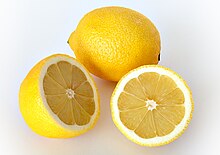
- Pomelo (also known as the shaddock) (Citrus paradisi)
- Citron (Citrus medica)
- Grapefruit
- Lemon (Citrus limon)
- Limes
- Key Lime (Citrus aurantifolia)
- Persian lime Also known as thaiti lime.
- Kaffir lime (Citrus hystix)
- Mandarin (Citrus reticulata),
- Clementine (Citrus reticulata var. Clementine),
- Tangerine, and similar
- Orange, of which there are sweet (Citrus sinensis) and sour (Citrus aurantium) species
- Hybrids of the preceding species, such as the Orangelo, Tangelo, Rangpur and Ugli fruit
Other subtropical fruits:
- Avocado (Persea americana; Lauraceae)
- Feijoa (Feijoa sellowiana; Myrtaceae)
- Guava (Psidium guajava; Myrtaceae)
- Kumquat (Fortunella spp.; Rutaceae)
- Longan (Euphoria longan; Sapindaceae)
- Lychee (Litchi chinensis; Sapindaceae)
- Passion fruit or Grenadilla (Passiflora edulis and other Passiflora spp.; Passifloraceae)
- Pond-apple (Annona glabra; Annonaceae) Also called Alligator-apple and Monkey-apple
- Strawberry guava (Psidium litorale; Myrtaceae)
- Tamarillo or Tree Tomato (Cyphomandra betacea; Solanaceae)
- Yangmei (Myrica rubra; Myricaceae) Also called Yamamomo, Chinese Bayberry, Japanese Bayberry, Red Bayberry, or Chinese strawberry tree
Tropical fruits[edit]
Tropical fruit grow on plants of all habitats. The only characteristic that they share is an intolerance of frost.
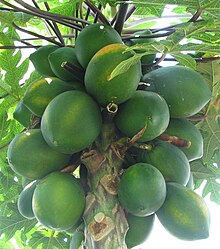
- Açaí (Euterpe oleracea; Arecaceae)
- Acerola (Malpighia glabra; Malpighiaceae)
- African cherry orange (Citropsis schweinfurthii; Rutaceae)
- Akee (Blighia sapida or Cupania sapida; Sapindaceae)
- Amazon Grape (Pourouma cecropiaefolia;Moraceae)
- Babaco (Carica pentagona; Caricaceae)
- Bael (Aegle marmelos; Rutaceae)
- Banana (Musacea spp.; Musaceae); its starchy variant is the plantain
- Barbados Cherry (Malpighia glabra L.; Malpighiaceae), also called Acerola, West Indian Cherry
- Bilimbi (Averrhoa bilimbi; Oxalidaceae) Also called cucumber tree or tree sorrel
- Breadfruit (Artocarpus altilis; Moraceae)
- Burmese grape (Baccaurea sapida; Euphorbiaceae)
- Calabash (Crescentia cujete; Cucurbitaceae)
- CamuCamu (Myrciaria dubia; Myrtaceae)
- Canistel (Pouteria campechiana; Sapotaceae)
- Carambola (Averrhoa carambola; Oxalidaceae), also called star fruit
- Cempedak (Artocarpus champeden; Moraceae)
- Cherimoya (Annona cherimola; Annonaceae)
- Coconut (Cocos spp.; Arecaceae)
- Custard apple (Annona reticulata; Annonaceae), also called Bullock's Heart
- Damson Plum (Chrysophyllum oliviforme; Sapotaceae), also called Satin Leaf
- Date-plum (Diospyros lotus; Ebenaceae)
- Dragonfruit (Hylocereus spp.; Cactaceae), also called pitaya
- Durian (Durio spp.; Bombacaceae)
- Eggfruit (Pouteria campechiana; Sapotaceae), also called canistel or yellow sapote
- Elephant apple (Dillenia indica; Dilleniaceae)
- Guarana (Paullinia cupana; Sapindaceae)
- Guavaberry or Rumberry; (Myrciaria floribunda; Myrtaceae)
- Horned melon (Cucumis metuliferus; Cucurbitaceae)
- Indian Prune (Flacourtia rukan; Flacourtiaceae)
- Jaboticaba (Myrciaria cauliflora; Myrtaceae), also called Brazilian Grape Tree
- Jackfruit (Artocarpus heterophyllus Moraceae), also called nangka
- Jambul (Syzygium cumini; Myrtaceae)
- Jatobá (Hymenae coubaril; Leguminosae) Caesalpinioideae)
- Jenipapo (Genipa americana; Rubiaceae)
- Keppel fruit (Stelechocarpus burakol; Annonaceae)
- Kandis (Garcinia forbesii; Clusiaceae)
- Kundong (Garcinia sp.; Clusiaceae)
- Langsat (Lansium domesticum), also called longkong or duku
- Mabolo, (Diospyros discolor; Ebenaceae) also known as a velvet persimmon
- Mamey sapote (Pouteria sapota; Sapotaceae)
- Mamoncillo (Melicoccus bijugatus; Sapindaceae), also known as quenepa, genip or Fijian Longan
- Mango (Mangifera indica; Anacardiaceae)
- Mangosteen (Garcinia mangostana; Clusiaceae)
- Marang (Artocarpus odoratissima; Moraceae), a breadfruit relative
- Monstera (Monstera deliciosa; Araceae) also called Swiss Cheese Plant, Split-leaf Philodendron
- Naranjilla, Lulo (Solanum quitoense; Solanaceae)
- Papaya (Carica papaya; Caricaceae)
- Peanut butter fruit (Bunchosia argentea; Malpighiaceae)
- Pequi or Souari Nut (Caryocar brasiliense; Caryocaraceae)
- Pineapple (Ananas comosus or Ananas sativas; Bromeliaceae)
- Pitomba (Eugenia luschnathiana or Talisia esculenta)
- Pupunha or peach-palm (Bactris gasipaes; Palmae)
- Poha or Cape Gooseberry (Physalis peruviana; Solanaceae)
- Poisonleaf (Dichapetalum cymosum) (?)
- Rambutan (Nephelium lappaceum; Sapindceae)
- Red Mombin (Spondias purpurea; Anacardiaceae)
- Riberry (Syzygium luehmannii; Myrtaceae), also called Lilly Pilly, Lillipilli, Chinese Apple
- Rose apple (Eugenia/Syzygium aquem; Myrtaceae), also called Malay apple
- Salak (Salacca edulis), also called snakefruit
- Sapodilla (Achras/Manilkara zapota; Sapotaceae), also called chiku, mespel, naseberry, sapadilla, snake fruit, sawo
- Soursop (Annona muricata; Annonaceae), also called guanabana
- Star apple (Chrysophyllum cainito), also called caimito
- Sugar apple (Annona squamosa; Annonaceae)
- Surinam Cherry (Eugenia uniflora; Myrtaceae) also called Brazilian Cherry, Cayenne Cherry, Pitanga
- Tamarind (Tamarindus indica; Caesalpiniaceae)
Vegetables[edit]
Western Brassicas[edit]

- Broccoli (Brassica oleracea Italica group)
- Brussels sprout (Brassica oleracea Gemmifera group)
- Cauliflower (Brassica oleracea Botrytis group)
- Cabbage (Brassica oleracea Capitata group)
- Kale (Brassica oleracea Acephala group))
- Rapini (Brassica rapa))
Oriental Brassicas[edit]
- Chinese broccoli (Brassica rapa var. alboglabra)
- Chinese cabbage (Brassica rapa var. pekinensis)
- Komatsuna (Brassica rapa var. perviridis)
- Mizuna greens (Brassica rapa var. nipposinica)
- Oriental mustard (Brassica juncea)
- Bok choy (Brassica rapa var. chinensis)
Leafy and salad vegetables[edit]

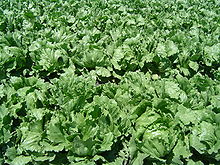
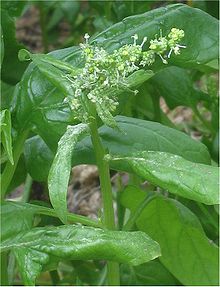
- Amaranth (Amaranthus spp)
- Arugula (Eruca sativa)
- Bitterleaf (Vernonia calvoana)
- Catsear (Hypochaeris radicata)
- Celtuce (Lactuca sativa var. asparagina)
- Ceylon spinach (Basella alba)
- Chicory (Cichorium intybus)
- Chinese Mallow (Malva verticillata)
- Chrysanthemum (Chrysanthemum coronarium)
- Corn salad (Valerianella locusta)
- Cress (Lepidium sativum)
- Dandelion (Taraxacum officinale)
- Endive (Cichorium endivia)
- Epazote (Chenopodium ambrosioides)
- Fat hen (Chenopodium album)
- Fiddlehead (Pteridium aquilinum, Athyrium esculentum)
- Fluted pumpkin (Telfairia occidentalis)
- Golden samphire (Inula crithmoides)
- Good King Henry (Chenopodium bonus-henricus)
- Iceplant (Mesembryanthemum crystallinum)
- Kuka (Adansonia spp.)
- Lagos bologi (Talinum fruticosum)
- Land cress (Barbarea verna)
- Lettuce (Lactuca sativa)
- Lizard's tail (Houttuynia cordata)
- Melokhia (Corchorus olitorius, Corchorus capsularis)
- Mustard (Sinapis alba)
- New Zealand Spinach (Tetragonia tetragonioides)
- Orache (Atriplex hortensis)
- Radicchio (Cichorium intybus)
- Samphire (Crithmum maritimum)
- Salad rape (Brassica napus)
- Sea beet (Beta vulgaris subsp. maritima)
- Seakale (Crambe maritima)
- Sierra Leone bologi (Crassocephalum spp.)
- Soko (Celosia argentea)
- Sorrel (Rumex acetosa)
- Spinach (Spinacia oleracea)
- Summer purslane (Portulaca oleracea)
- Swiss chard (Beta vulgaris subsp. cicla var. flavescens)
- Watercress (Nasturtium officinale)
- Water spinach (Ipomoea aquatica)
- Winter purslane (Claytonia perfoliata)
Fruiting and flowering vegetables[edit]
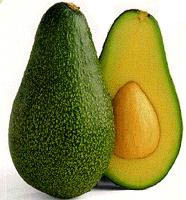
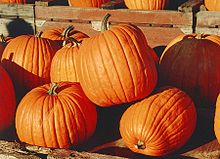
- Armenian cucumber (Cucumis melo Flexuosus group)
- Avocado (Persea americana)
- Bitter melon (Momordica charantia)
- Caigua (Cyclanthera pedata)
- Cayenne pepper (Capsicum frutescens)
- Chayote (Sechium edule)
- Chilli pepper (Capsicum annuum Longum group)
- Courgette (Cucurbita pepo)
- Cucumber (Cucumis sativus)
- Eggplant or Aubergine (Solanum melongena)
- Globe Artichoke (Cynara scolymus)
- Luffa (Luffa acutangula, Luffa aegyptiaca)
- Malabar gourd (Cucurbita ficifolia)
- Marrow (Cucurbita pepo)
- Melon (Cucumis melo)
- Parwal (Trichosanthes dioica)
- Perennial cucumber (Coccinia grandis)
- Pumpkin (Cucurbita maxima, Cucurbita pepo)
- Snake gourd (Trichosanthes cucumerina)
- Sweetcorn (Zea mays)
- Sweet pepper (Capsicum annuum Grossum group)
- Tinda (Praecitrullus fistulosus)
- Tomato (Lycopersicon esculentum)
- Watermelon (Citrullus lanatus)
- Winter melon (Benincasa hispida)
- West Indian gherkin (Cucumis anguria)
Podded vegetables[edit]


American groundnut (Apios americana)
- Asparagus pea (Psophocarpus tetragonolobus)
- Azuki bean (Vigna angularis)
- Black-eyed pea (Vigna unguiculata subsp. unguiculata)
- Chickpea (Cicer arietinum)
- Drumstick (Moringa oleifera)
- Dolichos bean (Lablab purpureus)
- Fava bean (Vicia faba)
- French bean (Phaseolus vulgaris)
- Guar (Cyamopsis tetragonoloba)
- Horse gram (Macrotyloma uniflorum)
- Indian pea (Lathyrus sativus)
- Lentil (Lens culinaris)
- Lima bean (Phaseolus lunatus)
- Moth bean (Vigna acontifolia)
- Mung bean (Vigna radiata)
- Okra (Abelmoschus esculentus)
- Pea (Pisum sativum)
- Peanut (Arachis hypogaea)
- Pigeon pea (Cajanus cajan)
- Rice bean (Vigna umbellatta)
- Runner bean (Phaseolus coccineus)
- Soybean (Glycine max) Pulses category
- Tarwi (Lupinus mutabilis)
- Tepary bean (Phaseolus acutifolius)
- Urad bean (Vigna mungo)
- Velvet bean (Mucuna pruriens)
- Yardlong bean (Vigna unguiculata subsp. sesquipedalis)
Bulb and stem vegetables[edit]

- Asparagus (Asparagus officinalis)
- Cardoon (Cynara cardunculus)
- Celeriac (Apium graveolens var. rapaceum)
- Celery (Apium graveolens)
- Elephant Garlic (Allium ampeloprasum var. ampeloprasum)
- Florence fennel (Foeniculum vulgare var. dulce)
- Garlic (Allium sativum)
- Kohlrabi (Brassica oleracea Gongylodes group)
- Kurrat (Allium ampeloprasum var. kurrat)
- Leek (Allium porrum)
- Onion (Allium cepa)
- Prussian asparagus (Ornithogalum pyrenaicum)
- Rhubarb (Rheum x cultorum)
- Shallot (Allium cepa Aggregatum group)
- Welsh onion (Allium fistulosum)
- Wild leek (Allium tricoccum)
Root and tuberous vegetables[edit]
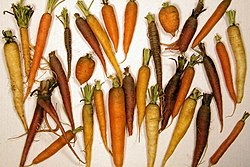
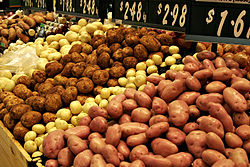

- Ahipa (Pachyrhizus ahipa)
- Arracacha (Arracacia xanthorrhiza))
- Beetroot (Beta vulgaris subsp. vulgaris)
- Black cumin (Bunium persicum)
- Broadleaf arrowhead (Sagittaria latifolia)
- Canna (Canna spp.)
- Carrot (Daucus carota)
- Cassava (Manihot esculenta)
- Chinese artichoke (Stachys affinis)
- Daikon (Raphanus sativus Longipinnatus group)
- Earthnut pea (Lathyrus tuberosus)
- Ensete (Ensete ventricosum)
- Ginger (Zingiber officinale)
- Gobo (Arctium lappa)
- Hamburg parsley (Petroselinum crispum var. tuberosum)
- Jerusalem artichoke (Helianthus tuberosus)
- Jícama (Pachyrhizus erosus)
- Lotus root (Nelumbo nucifera)
- Maca (Lepidium meyenii)
- Malanga (Xanthosoma sp.)
- Mashua (Tropaeolum tuberosum)
- Mauka (Mirabilis extensa)
- New Zealand rock lily (Arthropodium cirratum)
- Oca (Oxalis tuberosa)
- Parsnip (Pastinaca sativa)
- Pignut (Conopodium majus)
- Plectranthus (Plectranthus spp.)
- Potato (Solanum tuberosum)
- Prairie turnip (Psoralea esculenta)
- Radish (Raphanus sativus)
- Rutabaga (Brassica napus Napobrassica group)
- Salsify (Tragopogon porrifolius)
- Scorzonera (Scorzonera hispanica)
- Skirret (Sium sisarum)
- Sweet potato (Ipomoea batatas)
- Taro (Colocasia esculenta)
- Ti (Cordyline fruticosa)
- Tigernut (Cyperus esculentus)
- Turnip (Brassica rapa Rapifera group)
- Ulluco (Ullucus tuberosus)
- Wasabi (Wasabia japonica)
- Water chestnut (Eleocharis dulcis)
- Yacón (Smallanthus sonchifolius)
- Yam (Dioscorea spp.)
Seaweed[edit]

- Aonori (Monostroma spp., Enteromorpha spp.)
- Carola (Callophyllis variegata)
- Dabberlocks (Alaria esculenta)
- Dulse (Palmaria palmata)
- Hijiki (Hizikia fusiformis)
- Kombu (Laminaria japonica)
- Mozuku (Cladosiphon okamuranus)
- Nori (Porphyra spp.)
- Ogonori (Gracilaria spp.)
- Sea grape (Caulerpa spp.)
- Sea lettuce (Ulva lactuca)
- Wakame (Undaria pinnatifida)
Meat[edit]
Mammal[edit]
Poultry[edit]
Fish[edit]
See main article List of edible fish.
Whitefish[edit]
Some of the following are referred to as whitefish in the market, but are not whitefishes in a taxonomic sense.
- Anchovy
- Bass, particularly Striped bass (+) when farmed
- Black cod/Sablefish (+) when Alaskan or British Columbian
- Bluefish
- Butter fish
- Blowfish
- Bream
- Brill
- Catfish (+ when U.S. farmed)
- Cod, particularly Pacific cod (0) and Atlantic cod (-)
- Dogfish
- Eel
- Flounder
- Grouper
- Haddock
- Halibut (+) when Pacific
- Herring
- Kingfish
- John Dory
- Lamprey
- Lingcod (-)
- Mackerel
- Mahi Mahi (0)
- Monkfish
- Mullet
- Orange roughy (0)
- Patagonian toothfish (also known as Chilean Sea Bass) (-)
- Pike
- Pollock (0)
- Pomfret
- Pompano
- Sablefish
- Sanddab, particularly Pacific sanddab (0)
- Sardine (+)
- Salmon (+) when wild from California or Alaska; (0) when wild from Oregon or Washington; (-) when farmed or Atlantic
- Sea bass (+)
- Shark (-), except U.S. west coast Thresher shark (0)
- Skate
- Snapper, particularly Rockfish/Rock Cod/Pacific snapper (-) if trawl-caught, (0) otherwise
- Sole (0)
- Sturgeon (+) when farmed, (-) otherwise
- Surimi (0)
- Swordfish (0) when U.S. west coast, (-) otherwise
- Tilapia (+) when farmed
- Tilefish
- Trout, particularly Rainbow trout (+) when farmed
- Tuna, particularly Albacore tuna (+) when caught by trolling or pole, Yellowfin tuna (+) when caught by trolling or pole, Bigeye tuna (+) when caught by trolling or pole, and Bluefin tuna (-)
- Turbot
- Wahoo
- Whitefish
- Whiting
Roe[edit]
- Caviar (sturgeon roe) (+) when farmed
- Ikura (salmon roe)
- Kazunoko (herring roe)
- Lumpfish roe
- Masago (Capelin roe)
- Tobiko (Flying-fish roe)
Shellfish[edit]
Crustacean[edit]
- Crab, particularly Dungeness crab (+), King crab (0) when Alaskan, otherwise (-), Snow crab (+) when from Canada, (0) when from U.S.
- Crayfish
- Lobster, particularly American lobster (0) and Rock lobster/Spiny lobster (+) when Californian or Australian
- Shrimp/Prawns (+) when trap-caught, (0) when farmed or trawl-caught
Mollusks[edit]
- Abalone (+) when farmed, (-) when wild
- Clam (+) when farmed, (0) when wild
- Cockle
- Conch
- Cuttlefish
- Mussel (+) when farmed, (0) when wild
- Octopus
- Oyster (+) when farmed, (0) when wild
- Periwinkle
- Snail
- Squid (0)
- Scallop, specifically Bay scallop/Sea scallop (0)
Echinoderms[edit]
These creatures are consumed in some Asian cuisines.
- Sea Cucumber
- Uni (sea urchin "roe")
Milk (Dairy)[edit]
Junk foods[edit]
- Biscuits
- Candies
- Crackers
- Custards
- Food chips
- French Fries
- Gelatin desserts
- Ice creams
- Mousse
- Onion rings
- Pastries
- Pizza
- Popcorn
- Puddings
- Soft drinks
- Soufflés
- Sweets
- Trifles
Dietary supplements not listed above[edit]
Nutrients[edit]
- 5-HTP - higher bioavailable form of tryptophan, precursor to the neurotransmitter serotonin, promotes relaxed poise and sound sleep
- Alpha-GPC (L-alpha glycerylphosphorylcholine, Choline alfoscerate) - most effective choline precursor, readily crosses the blood-brain barrier
- Caffeine - improves concentration, idea production, but hinders memory encoding. Also produces the jitters.
- Acetyl-L-carnitine (ALCAR) - Amino acid. Transports fatty acids through cellular membranes and cytosol into cells' mitochondria, where the fats undergo oxidation to produce ATP, the universal energy molecule. Synergistic with lipoic acid. Precursor of acetylcholine (donating the acetyl portion). Inhibits lipfuscin formation.
- CDP-Choline (Cytidine Diphosphate Choline) - choline precursor, a more economical alternative to Alpha GPC
- Choline bitartrate - precursor of acetylcholine, general nootropic, anti-depressant
- Choline citrate - precursor of the neurotransmitter acetylcholine, general nootropic, anti-depressant.
- Chondroitin sulfate -
- Coenzyme q-10- increases oxygen transport through the mitocondria of the cells. Appears to slow age-related dementia
- Creatine - increases brain energy levels via ATP production
- DMAE - approved treatment for ADD/ADHD, precursor of acetylcholine, cholinergic agent, removes lipofuscin from the brain, anti-depressant
- Egg protein -
- Ephedrine -
- Flavonoid (aka bioflavonoid) -
- Gamma-aminobutyric acid (GABA) -
- Garum armoricum extract - Adaptogen.
- Glucosamine -
- Glycyrrhizic Acid -
- Huperzine A - potent acetylcholinesterase inhibitor derived from Chinese club-moss.
- Idebenone - stimulates nerve growth, and has same effects as Coenzyme q-10 without its harmful side-effects
- Inositol - Alternative source of energy. Stimulates creativity.
- Lecithin - precursor of acetylcholine
- Lipoic acid - synergistic with Acetyl-L-carnitine.
- Phenibut -
- Pregnenolone -
- Phosphatidyl-serine
- Resveratrol -
- Theanine - Amino acid. Found in tea. Increases serotonin and dopamine levels in the brain. Increases alpha-wave based alert relaxation.
- Theophylline -
- Vinpocetine - micro-circulation enhancer, improves oxygen supply to brain cells
- Yeast, nutritional -
Herbs and Spices[edit]

- Adelma Simmons
- Aglaophotis
- Aglaophotis
- Alino crio
- Allspice
- Aloe Vera
- Ambrosia herbs
- Amchur (mango powder)
- Angelica (Angelica archangelica)
- Anise
- Annatto
- Apple mint
- Arrowroot
- Artemisia vulgaris
- Rocket (Arugula)
- Asafoetida
- Asarum europaeum
- Ashwagandha (Withania somnifera) - Root. Adaptogen. Also known as Indian ginseng. Adaptogen used as tonics to normalize body processes and reduce stress and anxiety.
- Bacopa monnieri (Brahmi) - Herb. Elevates curiosity, enhances memory and concentration, improves protein synthesis in brain cell repair and new dendritic growth.
- Barberry
- Basil (Ocimum basilicum)
- Bay Laurel
- Bay leaves
- Berebere
- Bison grass (Hierochloe odorata)
- Bitters
- Black cardamom
- Black cumin
- Black limes
- Pepper (black, white, and green)
- Blue Cohosh
- Bog Labrador tea
- Boldo
- Bolivian Coriander (Porophyllum ruderale)
- Borage (Borago officinalis)
- Bush tomato
- Calamus
- Camomile
- Candle nut
- Caper (Capparis spinosa)
- Caraway
- Cardamom
- Carob Pod
- Catsear
- Celastrus Panicaltus - Herb.
- Celery salt
- Celery seed
- Chervil (Anthriscus cerefolium)
- Chicory
- Chile pepper
- Chili powder
- Chives (Allium schoenoprasum)
- Cicely (Myrrhis odorata)
- [[Cilantro (see Coriander) (Coriandrum sativum)
- Cinnamon (and Cassia)
- Clary
- Cloves
- Coffee - Bean. Contains caffeine; brewed coffee is high in antioxidants.
- Comfrey
- Common Rue
- Coptis
- Coriander
- Costmary (Tanacetum balsamita)
- Cow Parsley
- Cress
- Cuban Oregano
- Cumin
- Curry powder
- Curry leaf (Murraya koenigii)
- Lemongrass (Cymbopogon citratus, C. flexuosus, and other species)
- Damiana (Turnera aphrodisiaca, T. diffusa)
- Dandelion (Taraxacum officinale)
- Demulcent
- Devil's claw (Harpagophytum procumbens) medicinal
- Dill seed
- Dill (Anethum graveolens)
- Echinacea -
- Echinopanax Elatum (root) - adaptogen
- Edelweiss
- Elderberry
- Eleutherococcus senticosus (root) - adaptogen
- Emmenagogue
- Epazote (Chenopodium ambrosioides)
- Ephedra -
- Eryngium foetidum
- Fennel (Foeniculum vulgare)
- Fenugreek
- Filé powder
- Five-spice powder (Chinese)
- Fo-ti-tieng
- Galangal
- Garam masala
- Garden cress
- Garlic chives
- Garlic
- Ginger root
- Ginkgo biloba - Root. Adaptogen. Increases blood flow to the extremities including the brain, nootropic effects are disputed.
- Ginseng - adaptogen
- Ginseng, Siberian (Eleutherococcus senticosus) - Root. Anti-anxiety adaptogen that normalizes physical stress and mental consequences.
- Gotu Kola - Herb and root.
- Grains of paradise
- Grape seed extract
- Green tea
- Guaco
- Hawthorn (Crataegus sanguinea) extract (fruit) - adaptogen
- Hawthorne Tree
- Herbes de Provence
- Horseradish
- Hyssop (Hyssopus officinalis)
- Jalap
- Jamaican jerk spice
- Jiaogulan (Gynostemma pentaphyllum) - adaptogen
- John the Conqueror
- Juniper
- Kaffir Lime Leaves (Citrus hystrix, C. papedia)
- Kokam
- Labrador tea
- Land cress
- Lavender (Lavandula spp.)
- Ledum
- Lemon Balm (Melissa Officinalis) - Herb. Anti-depressant.
- Lemon basil
- Lemon mint
- Lemon Myrtle (Backhousia citriodora)
- Lemon verbena (Lippia citriodora)
- Licorice - adaptogen
- Limnophila aromatica
- Long pepper
- Lovage (Levisticum officinale)
- Luohanguo
- Mahlab
- Malabathrum
- Manchurian Thorn Tree (Aralia manchurica)]] (root) - adaptogen
- Marjoram (Origanum majorana)
- Marrubium vulgare
- Marsh Labrador Tea
- Mastic
- Meadowsweet
- Mentha
- Mint (Mentha spp.)
- Milk thistle (Silybum)
- Bergamot (Monarda didyma)
- Mountain Skullcap
- Mullien (Verbascum thapsus)
- Mustard
- Mustard seed
- Nashia inaguensis
- Nepeta
- Nigella sativa
- Nigella (Kolanji, Black caraway)
- Noni - adaptogen
- Nutmeg (and Mace)
- Evening primrose (Oenothera biennis et al.)
- Oregano (Origanum vulgare, O. heracleoticum, and other species)
- Orris root
- Osmorhiza
- Panax quinquefolius
- Ponch phoran
- Pandan leaf
- Paprika
- Parsley (Petroselinum crispum)
- Peppermint
- Perilla
- Pomegranate seeds (though some consider these a fruit, not a spice)
- Poppy seed
- Primrose (Primula) — candied flowers, tea
- Purslane
- Quatre épices
- Ramsons
- Ras-el hanout
- Raspberry (leaves)
- Rhodiola Rosea - Herb. Adaptogen; elevates mood, alleviates depression. Promotes mental energy and stamina, reduces fatigue.
- Roman chamomile
- Rosemary (Rosmarinus officinalis)
- Rue
- Sage (Salvia officinalis)
- Safflower
- Saffron
- Saigon Cinnamon
- Salad Burnet (Sanguisorba minor or Poterium sanguisorba)
- Salvia
- Sansho
- Sassafras
- Savory (Satureja hortensis, S. montana)
- Schisandra (Schisandra chinensis) (seed) - adaptogen
- Scutellaria costaricana
- Senna (herb)
- Senna obtusifolia
- Sesame seed
- Sialagogue
- Siberian Chaga (Inonotus obliques) - adaptogen
- Siberian ginseng (Eleutherococcus senticosus) - Root. Anti-anxiety adaptogen that normalizes physical stress and mental consequences.
- Siraitia grosvenorii (luohanguo)
- Smudge stick
- Sonchus
- Sorrel (Rumex spp.)
- Spearmint
- St John's Wort - Herb. The active components: hypericin and hyperforin, are clinically indicated to be effective in cases of mild to medium depression.
- Star anise
- Stevia
- Suma (Pfaffia paniculata) - adaptogen
- Sumac
- Summer savory
- Sutherlandia frutescens - Herb. Adaptogen, blood detoxifier.
- Sweet grass
- Sweet cicely (Myrrhis odorata)
- Sweet woodruff
- Szechuan pepper (Xanthoxylum piperitum)
- Tamarind
- Tandoori masala
- Tansy
- Tarragon (Artemisia dracunculus)
- Tea - Herb. Contains theophylline and theanine. Increases alpha-wave based alert relaxation (relieves stress).
- Teucrium polium
- Thai basil
- Thyme
- Tribulus terrestris
- Tulsi (Ocimum tenuiflorum) - adaptogen
- Turmeric
- Vanilla (Vanilla planifolia)
- Vasaka
- Vietnamese Coriander
- Wasabi
- Watercress
- Wattleseed
- Wild ginger
- Wild thyme
- Winter savory
- Wolfberry
- Woodruff
- Yarrow
- Yerba Buena
- Yohimbe - Bark. Boosts dopamine levels as much as 80%, though how it does this is not yet understood. Aphrodesiac. Yohimbe poses some health risks through its side-effects: it is a neuro-paralytic which slows down breathing and induces acidosis, some symptoms of which are malaise, nausea, and vomiting. Contraindicated for users of megadoses of acidic vitamins or nutrients.
- Za'atar
See also[edit]
Profession:
Food:
Health:
- Auxology
- Digestion
- Calorie restriction
- Eating disorders
- Health
- Healthy eating
- Hygiene
- Illnesses related to poor nutrition
- Life extension
- Nutrition and pregnancy
- Obesity
Research:
